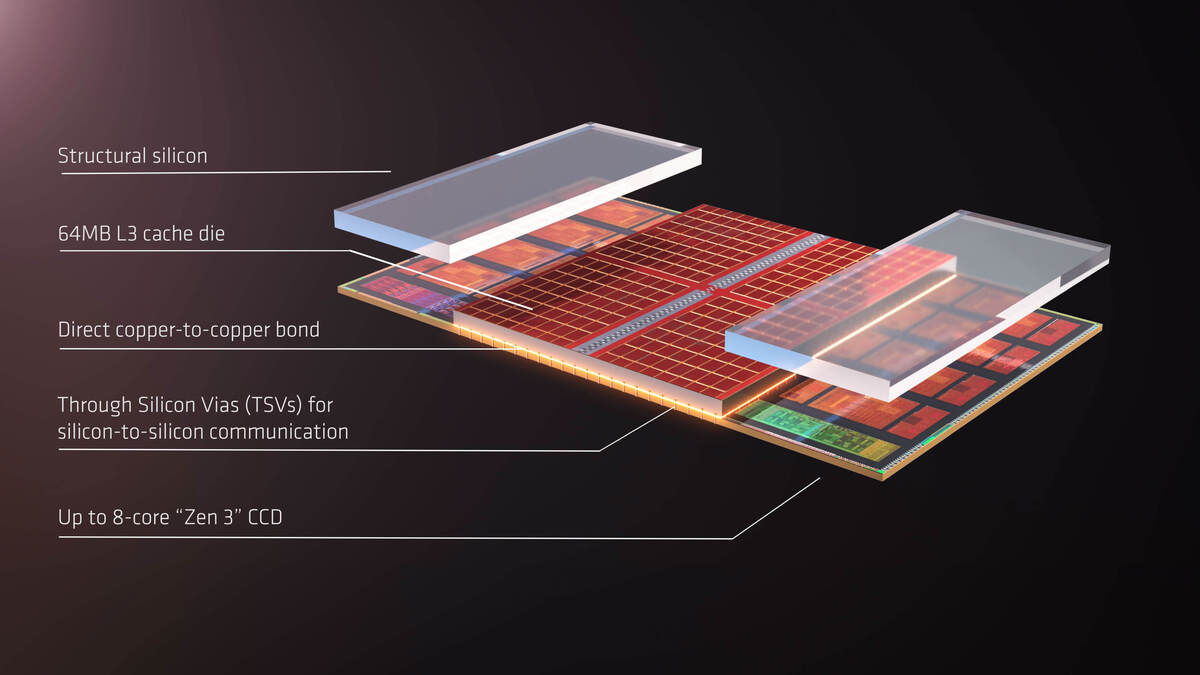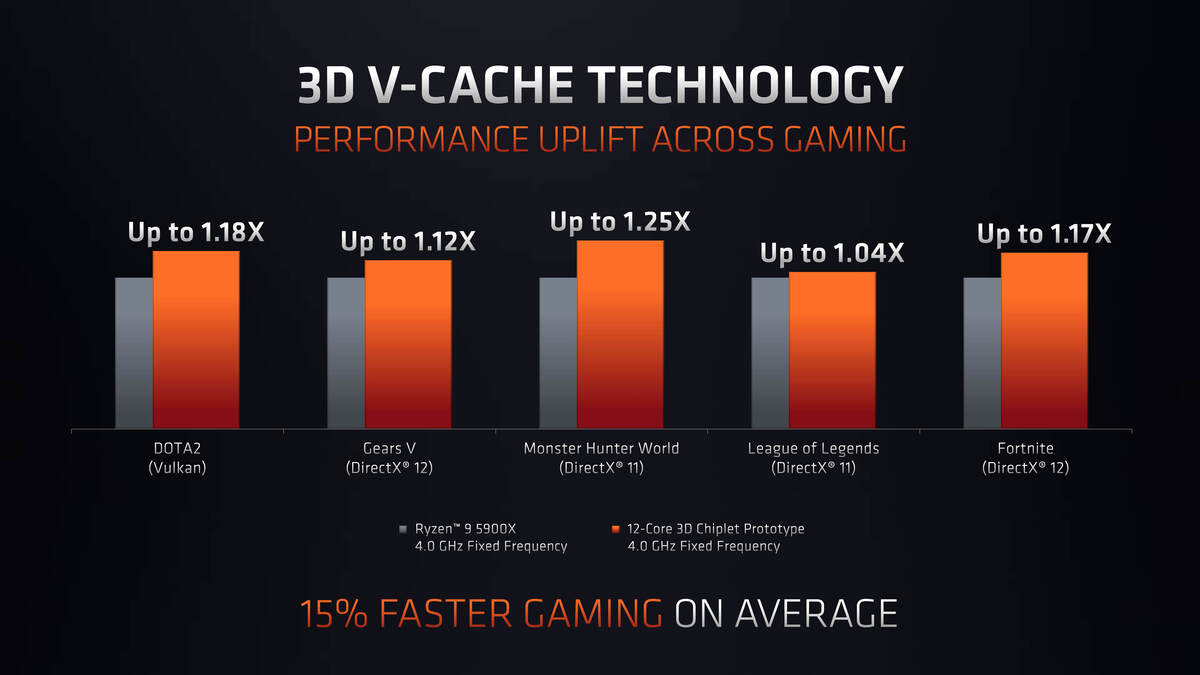All about AMD’s revolutionary V-Cache for Ryzen
AMD’s mic-drop moment at Computex was the news of its closely guarded “V-Cache” technology, which would enable chip stacking on Ryzen CPUs.
PCWorld interviewed AMD’s Sam Naffziger about V-Cache. We boiled down that conversation into a baker’s dozen of key things you need to know.
 AMD
AMDThe V-Cache in the CPU above sits above the existing CPU’s L3 cache. Additional silicon next to it is used to stiffen the die and convey heat to the heat spreader.
What is V-Cache?
V-Cache uses TSMC’s SoIC (System on Integrated Chips) chip-stacking technology to add 64MB of SRAM L3 cache to the compute dies of existing Zen 3-based Ryzen CPUs. That will basically triple the amount of cache to an insane 192MB of L3 for the 12-core and 16-core versions of AMD’s CPUs.
V-Cache will come to Zen 3-based Ryzen CPUs later this year
There was a little confusion as to which CPUs would get V-Cache, and when, as AMD CEO Lisa Su held up a prototype Ryzen with the technology. The company has since confirmed that yes, V-Cache will come to high-end, Zen 3-based Ryzen CPUs at the end of the year.
 AMD
AMDAMD previously used TSV (Through-Silicon Via) technology in its original Vega GPU’s HBM memory. As you can see, it channels through the silicon itself to connect to the next layer down.
How is V-Cache connected?
The individual 64MB SRAM cache will be stacked on each compute die over the existing L3 cache and be connected using a technology called Through-Silicon Via, which connects stacked chips using a tunneling system. This isn’t AMD’s first experience with TSV: The original Vega GPU with its HBM memory also used TSV technology.
Latency shouldn’t be an issue
One concern with the large amount of L3 is latency, or delay, as the CPU fetches instructions or data from the cache. AMD’s Naffziger said that shouldn’t be a problem with V-Cache, because the TSV construction offers a more direct route to the cache.
How fast will V-Cache be?
AMD is touting a jaw-dropping 2TBps and beyond of bandwidth for V-Cache. That’s insanely fast. As a comparison, Intel’s 2013-era Core i7-4770R “Crystal Well” chip, which featured an impressive 128MB of eDRAM L4, offered about 100GBps of bandwidth at the time.
Can you stack more V-Cache on top of each other?
Although that may not happen with the first Ryzen chips with V-Cache, there’s nothing that would prevent the stacking of V-Cache.
Won’t V-Cache make it harder to cool the CPU?
It might seem crazy to taking a hot CPU die and throw a silicon blanket over it, blocking its contact with the thermal interface material and heat spreader. AMD’s Naffziger said that won’t be an issue, because the actual SRAM L3 sits on the existing L3 cache on the die. The actual CPU cores that generate most of the heat will have a layer of silicon that will convey heat to the TIM and heat spreader.
Developers don’t need to optimize for it
The V-Cache will function in a seamless manner to applications and games, so developers don’t need to issue patches or software updates to take advantage of it. Fire up a game or app, and it’ll just see a big ol’ bucket of 192MB of L3 cache.
 AMD
AMDAMD said about a 15 percent bump was seen from just the V-Cache.
What will V-Cache make faster?
AMD so far has showed off very impressive gains in gaming using a standard Ryzen against one with V-Cache locked at 4GHz. AMD showed gains from 4 percent to 25 percent just from the additional L3 cache. That’s about a 15-percent gain on average, which the company said is equivalent to an entire generational CPU change.
Will V-Cache help make anything else go faster?
So far, AMD has declined to list performance increases in anything other than gaming, but we suspect that’s because it’s saving that for later. Naffziger did say you can look at already published studies of performance increases from additional L3 cache. We believe V-Cache could offer very good performance increases depending on the application, but we’ll have to wait and see before we can say for sure.
Will V-Cache work with existing AM4 motherboards?
AMD did not say which motherboard sockets the first V-Cache Ryzen CPUs will go into, but we’re pretty certain it’ll be the existing stock of AM4 motherboards. That would be great news for upgraders who want to eke out one more CPU on an existing system. Naffziger said the thickness from V-Cache won’t change the Z-height, or thickness, of the actual Ryzen CPU. That pretty much says AMD has done all it can to make sure V-Cache-based Ryzen chips will work with the existing infrastructure of heat sinks and motherboards.
 Samsung
SamsungDDR5 is on the way and promises much higher capacity and much higher bandwidth too—and in all likelyhood—much higher initial prices too.
Does this mean Zen 4 might come sooner?
Besides the V-Cache news, AMD’s Lisa Su confirmed that the company’s Zen 4 cores will be based on TSMC’s 5nm process, which will be due sometime in 2022. Those hoping to see Zen 4 and its promise of DDR5 support sooner might feel let down, but memory transitions can be fraught with painful price hikes, too. If V-Cache on an existing Zen 3-based platform can go toe-to-toe with Intel’s CPUs, AMD can introduce Zen 4 with DDR5 when it’s far more affordable than it’s likely to be when the new RAM is first released.
How will V-Cache and Zen 3 Ryzen compare with Intel’s upcoming Alder Lake?
This is truly the million-transistor question we’ll face as we close this year out: Will Intel’s 10nm-based “big-little” design in Alder Lake put it back in black against AMD’s Ryzen? If anyone tells you they know the answer, they’re lying. We’ll have to wait until we see Intel’s Alder Lake parts and AMD’s V-Cache-based Ryzen before anyone can answer this question.
When can I buy a Ryzen with V-Cache?
There are no hard details on when you’ll be able to buy a CPU with V-Cache. About as close we can get is “production later this year,” so we’d guess it’ll arrive before the holiday shopping season begins.
For all the latest Technology News Click Here
For the latest news and updates, follow us on Google News.
